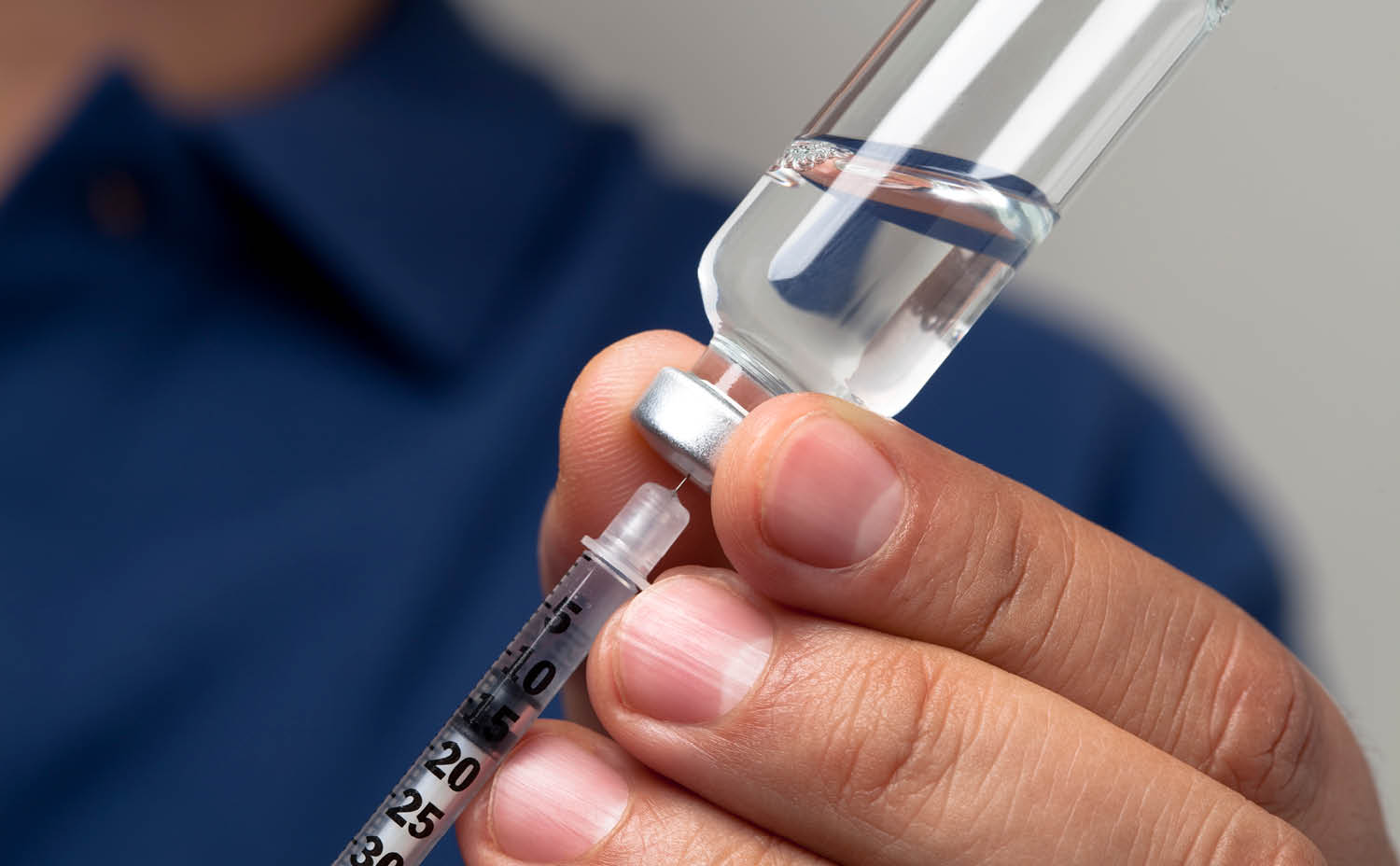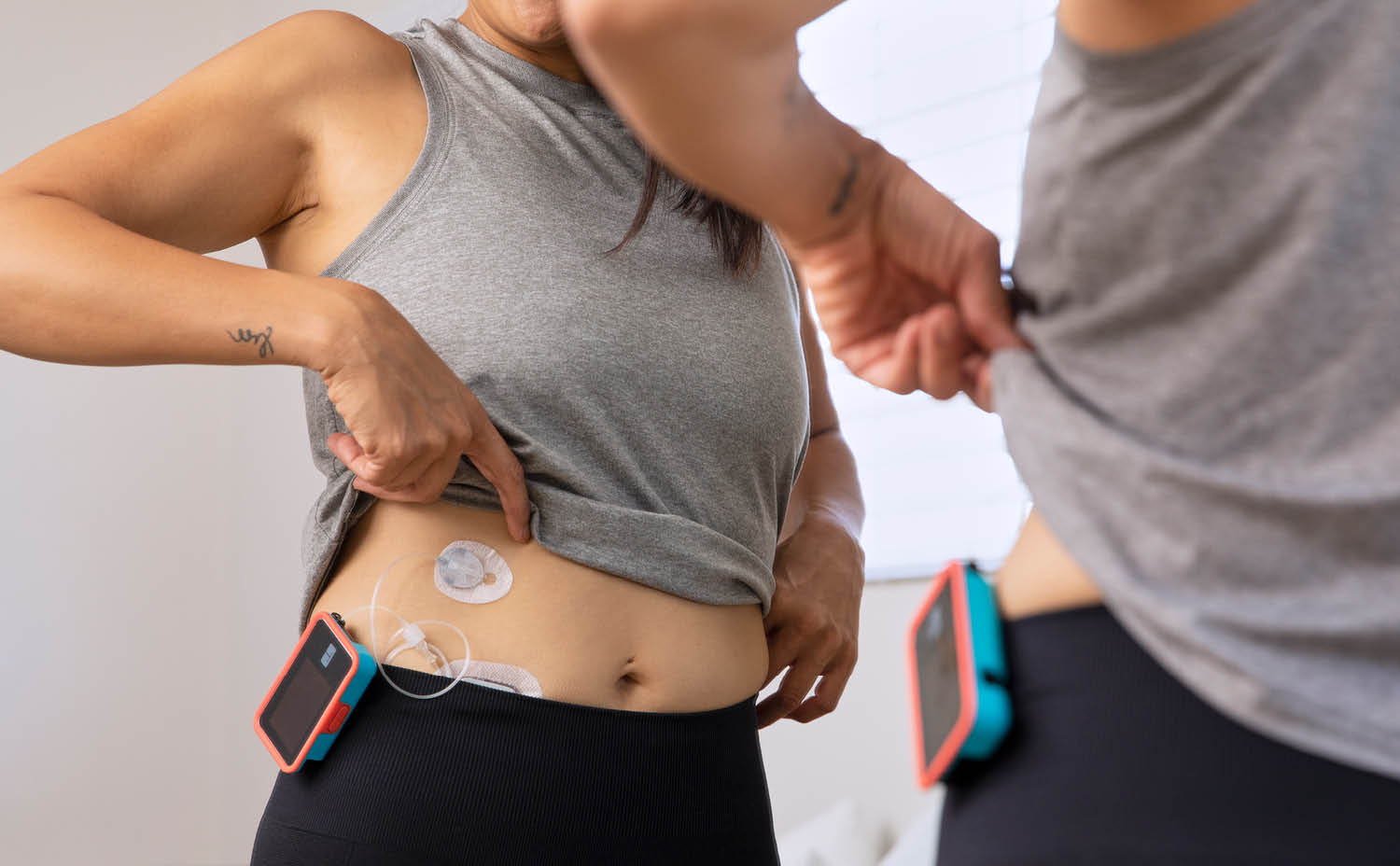Everything a person does requires energy. When someone is running, eating, sleeping, and thinking, the body needs energy. In order to make that energy, the body uses a hormone called insulin, which originates in the pancreas. Insulin allows the body to generate energy from glucose.
Hormones are the messengers of the body and can help regulate everything from the body’s development to metabolism. In the case of insulin, this particular hormone is responsible for telling cells to allow glucose (blood sugar) to enter and become energy.
Someone living with type 1 diabetes either doesn’t make any, or enough, insulin and requires insulin therapy. Type 1 diabetes is considered an autoimmune disease.
Someone living with type 2 diabetes may not be able to use the insulin they are producing effectively due to insulin resistance, meaning the body is forced to produce more insulin to allow glucose to be converted into energy. Most people diagnosed with type 2 diabetes have had diabetes for more than five years before they are treated. It’s important to treat type 2 diabetes and there are many effective therapies that can be used.

How Does Insulin Work?
Here’s an easy-to-follow explanation from Jordan Pinsker, vice president and medical director at Tandem Diabetes Care and a leading pediatric endocrinologist:
“Insulin is like the key to a door lock. When you have diabetes, all of the carbohydrates get converted into sugar, or glucose, that floats around in your blood. You eat sugar, you drink sugar, and it’s floating around. But it can’t get into your body because the cells of your body act like they have a locked door. Insulin is the key that opens the door, opens the lock, and lets your body absorb the glucose.”
Where Does Insulin Come From?
Insulin is produced in the pancreas, a gland located in the abdomen. It produces enzymes that aid in digestion, along with hormones that help to regulate glucose levels.
The pancreas is very efficient at delivering insulin when needed. In someone with normal insulin function, the pancreas is constantly delivering insulin to all different parts of the body.
“When you’re running and exercising, your muscles need glucose, and insulin lets those muscle cells absorb glucose,” Dr. Pinsker explained. “When you’re thinking, your brain needs glucose. Your brain is actually the biggest user of glucose. Insulin allows that glucose to go into your brain.”
For someone living with type 1 diabetes, glucose is unable to enter those cells because they lack the key — i.e., insulin. Thus, there is a buildup of blood sugars, which are eventually let out of the body through urine.
How is Replacement Insulin Made?
Insulin was first discovered at the University of Toronto in 1921 by Sir Frederick G. Banting, Charles Best, and John Macleod. Biochemist James Collip would later work with the group to purify the insulin, which was originally drawn from dogs to make it safe for humans.
All of the insulin people take today is synthetic, and researchers are constantly looking for ways to make synthetic insulin work faster as it is injected.
The body is smart and efficient, and insulin works properly through a feedback loop. The loop senses when glucose in the blood stream is rising and secretes insulin to meet the body’s needs. However, for someone who has diabetes, this isn’t an option.
Instead, insulin must be delivered into the system from an external source, and then it needs to work its way into the circulatory system. The very efficient feedback loop is broken, and the person must check their glucose (either through a fingerstick blood drop or through a continuous glucose monitoring [CGM] sensor) and help dose insulin to keep glucose under control. This all takes time, and researchers have developed several types of insulin for specific scenarios.
What are the Types of Insulin?
- Basal: Basal insulin, sometimes called background insulin, helps regulate glucose throughout the day, but does not account for blood sugar spikes that occur, for instance, during meals
- Bolus: Bolus insulin is a fast-acting dose of insulin that is usually delivered before a meal to account for the large spike in glucose. The hope is that the bolus will match the carbohydrates and help to absorb them correctly.
“When you eat food, your blood sugar is going to go way up because you can’t absorb all of that glucose with just your background (basal) insulin,” said Dr. Pinsker. “You need what is called a bolus, a big dose of insulin taken just before eating because it takes a few minutes for insulin to kick in. Matching a bolus dose to food is sometimes very challenging when you consider day-to-day changes. One day you might have an insulin sensitivity. Another day, you have to take into account whether you exercised. Counting carbohydrates and other macronutrients is very challenging because each day is different.”
To account for the different types of insulin and the different needs throughout the day or night, there are several “speeds” in which the insulin may start working, including rapid-acting and long-acting.
(NOTE: Always consult with a healthcare professional before trying or altering an insulin therapy regimen.)

How is Insulin Administered?
Although there are several ways for insulin to be delivered into the body — they all involve getting it under the skin. Each has its own advantages, and one delivery method might not work for everyone. It is important to note that some delivery systems require additional testing before use.
Here are the most common ways to administer insulin:
Injections: Using a syringe, insulin is drawn from a vial and injected below the skin.
Pens: Like syringes, pens are used for injections. But they have the insulin pre-loaded so there is no need to draw the insulin from a vial. This is particularly helpful for people with vision or dexterity issues because the number of units is easier to select.
A note from Dr. Pinsker on injections with either syringes or pens:
“If you’re using multiple daily injections, what we call MDI therapy, it is important to rotate the injection sites to prevent reactions in the skin or swelling beneath the skin. If this happens, it’s harder for the insulin to get absorbed.
“Rotate spots between the abdomen, the upper arm, thigh, lower back, hips, or buttocks. A right-handed person instinctively wants to inject their left arm. But if you do it over and over, that area develops a numbness.”
Inhaled: Inhaled insulin acts quickly and then also exits the body quickly. Per Dr. Pinsker, there are some who will need a second dose during meals because it can wear off too soon.
Important note: Inhaled insulin is not approved in pediatrics and additional lung function tests may be required before use.
Insulin pumps: Insulin pumps started as an alternative to multiple daily injections — or to at least reduce the number of injections. Early pumps focused on basal insulin delivery, or background insulin, which Dr. Pinsker correlates to “an irrigation drip system” that kept going in the background. And these devices offered the ability to give a bolus dose of insulin by just pressing the “Bolus” button on the pump. Pumps also offer bolus calculators that help someone with diabetes determine an insulin dose for the amount of carbohydrates they are eating.
However, pump technology has evolved significantly. And once they started “talking” to CGM sensors, it opened up a wide range of enhanced possibilities through hybrid closed-loop systems and automated insulin delivery.
For example, the t:slim X2™ insulin pump with Control-IQ® technology can anticipate blood glucose levels 30 minutes in advance and automatically adjust dosing when paired with the Dexcom G6 continuous glucose monitoring (CGM) sensor (sold separately). This can help to increase time in range,* improve sleep, and the addition of Personal Profiles can help someone living with type 1 diabetes improve their day-to-day diabetes management.
Visit tandemdiabetes.com/control-IQ for more information about the t:slim X2 insulin pump with Control-IQ technology, which has been cleared for type 1 diabetes treatment by people as young as six.
Unless otherwise noted, all medical information was provided by Jordan Pinsker, MD, and Molly McElwee Malloy, RN, CDCES of Tandem Diabetes Care, Inc.
*As measured by CGM.
RESPONSIBLE USE CONTROL-IQ TECHNOLOGY
Control-IQ technology does not prevent all highs and lows. You must still bolus for meals and actively manage your diabetes. Please visit tandemdiabetes.com/tslimX2-use for more information.
Important Safety Information
RX ONLY. The t:slim X2 pump and Control-IQ technology are intended for single patient use. The t:slim X2 pump and Control-IQ technology are indicated for use with NovoLog or Humalog U-100 insulin.
t:slim X2 insulin pump: The t:slim X2 insulin pump with interoperable technology is an alternate controller enabled (ACE) pump that is intended for the subcutaneous delivery of insulin, at set and variable rates, for the management of diabetes mellitus in people requiring insulin. The pump is able to reliably and securely communicate with compatible, digitally connected devices, including automated insulin dosing software, to receive, execute, and confirm commands from these devices. The t:slim X2 pump is indicated for use in individuals six years of age and greater. Control-IQ technology: Control-IQ technology is intended for use with a compatible integrated continuous glucose monitor (iCGM, sold separately) and ACE pump to automatically increase, decrease, and suspend delivery of basal insulin based on iCGM readings and predicted glucose values. It can also deliver correction boluses when the glucose value is predicted to exceed a predefined threshold. Control-IQ technology is intended for the management of Type 1 diabetes mellitus in persons six years of age and greater.
WARNING: Control-IQ technology should not be used by anyone under the age of six years old. It should also not be used in patients who require less than 10 units of insulin per day or who weigh less than 55 pounds. |
Control-IQ technology is not indicated for use in pregnant women, people on dialysis, or critically ill patients. Do not use Control-IQ technology if using hydroxyurea. Users of the t:slim X2 pump and Control-IQ technology must: use the insulin pump, CGM, and all other system components in accordance with their respective instructions for use; test blood glucose levels as recommended by their healthcare provider; demonstrate adequate carb-counting skills; maintain sufficient diabetes self-care skills; see healthcare provider(s) regularly; and have adequate vision and/or hearing to recognize all functions of the pump, including alerts, alarms, and reminders. The t:slim X2 pump and the CGM transmitter and sensor must be removed before MRI, CT, or diathermy treatment. Visit tandemdiabetes.com/safetyinfo for additional important safety information.